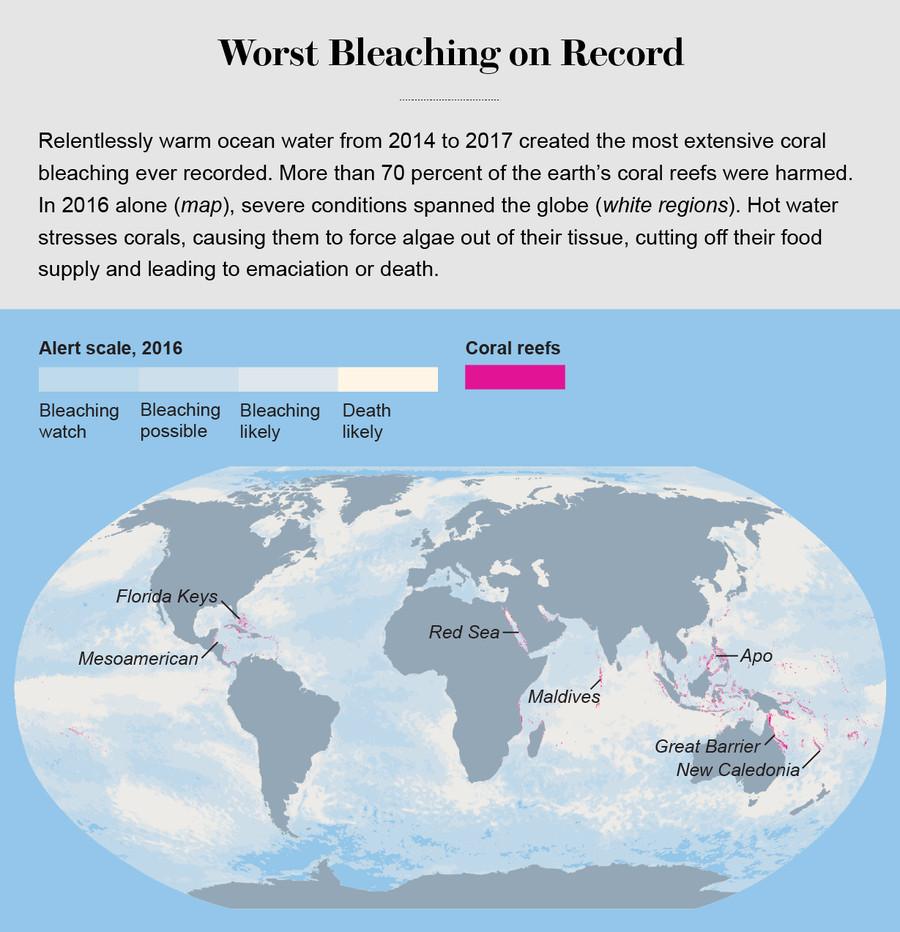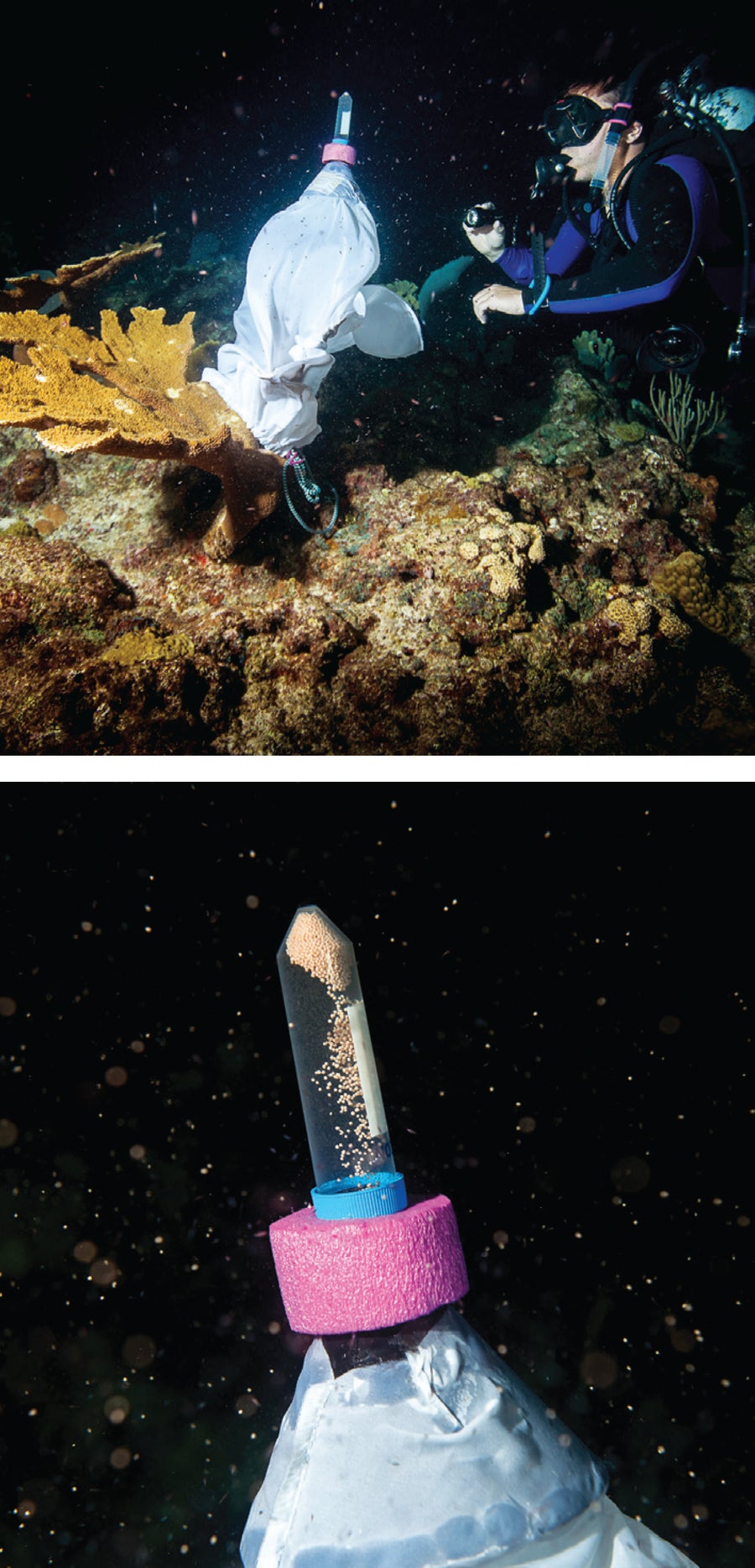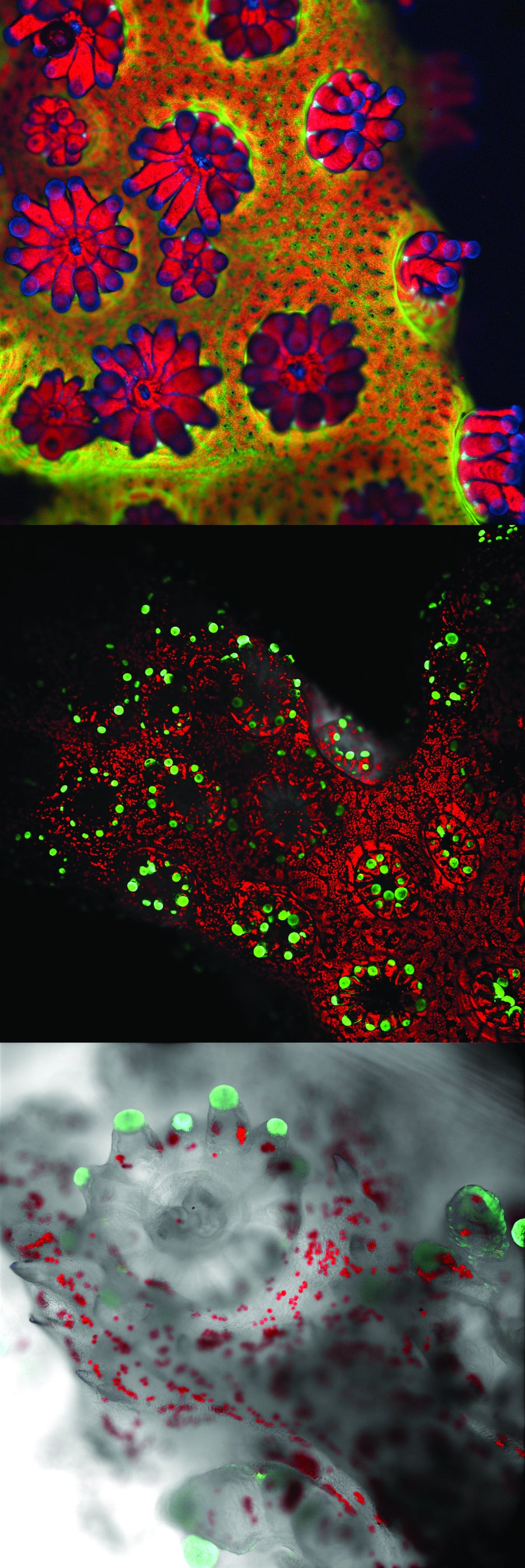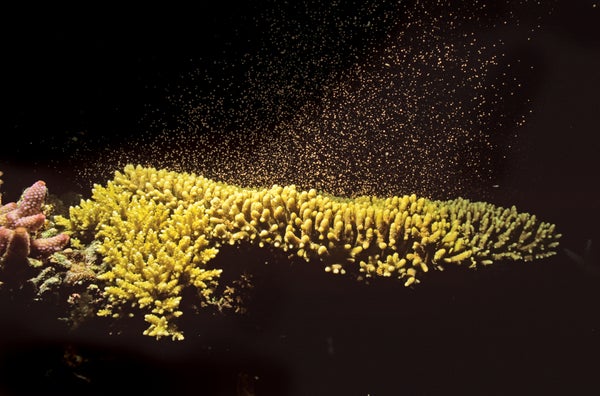I’m standing on a beach in Australia, toes digging into the sand, zipping up my wet suit before I dive down to the Great Barrier Reef. As I stare out at the ocean, I’m excited by memories of my previous dive at this site a decade earlier. Growing up in Ohio, I had spent my childhood reading A Day in the Life of a Marine Biologist when I wasn’t glued to the Discovery Channel. I got certified for scuba diving in one of Ohio’s murky limestone quarries and made it to the Great Barrier Reef a year later. I’m remembering the anticipation squeezing my chest the day of that dive. My friend Emily, now an expert in marine algae, and I took bets on how long we could make our air last, which turned out to be about two magical hours. We were mesmerized by a forest of vibrant corals teaming with cuttlefish, giant purple clams and graceful sea turtles.
Now I am back, this time as a postdoctoral researcher at the Australian Institute of Marine Science. I wade in up to my chin, tip my head underwater and look through my mask. My heart drops. Gone are the cuttlefish. Gone are the giant clams. Gone are the turtles. The corals are drab. Most of the thriving life has been replaced by algae and sediment. Although I know senior scientists who shared gut-wrenching stories of how a particular reef had degraded over their long careers, I feel I am too young—barely 10 years in—to see this alarming degree of change. Shouldn’t I be having this experience at the end of my tenure, not the beginning? Or better yet, not at all?
My shocked realization happened in 2014, as the third global mass-bleaching event began. Corals, often mistaken for rocks, are made of living animal tissue that contains microscopic algae, which provide the organism with food and give it color. When rising ocean temperature stresses corals, they expel the algae, causing the tissue to bleach—turn white—and leaving it vulnerable to starvation and disease. The mass bleaching persisted for three years, ruining reefs and breaking hearts worldwide. Although coral reefs can be threatened by overfishing, pollution and ocean acidification, the rapid and widespread destruction from warming is the greatest concern today.
On supporting science journalism
If you're enjoying this article, consider supporting our award-winning journalism by subscribing. By purchasing a subscription you are helping to ensure the future of impactful stories about the discoveries and ideas shaping our world today.
.jpg?w=900)
Divers secure new coral fragments raised onshore at Florida's Mote Marine Laboratory back onto a reef so they will grow and fill it in, a strategy similar to reforestation on land. Credit: Joe Berg Way Down Video
The first major global bleaching events hit in 1998 and 2010, each time triggered by warming seas worsened by El Niño conditions. The 2014–2017 event was by far the longest and most extensive, harming more than 70 percent of the world’s coral reefs. Two thirds of the Great Barrier Reef were reported as dead or severely bleached, and the devastating effects continue. Reefs are disappearing before our eyes. In the past 30 years we have lost around 50 percent of corals globally, and a recent report released by the United Nations’s Intergovernmental Panel on Climate Change (IPCC) estimates we’re at risk of losing more than 90 percent of coral reefs by 2050. We need solutions, and we need them fast.
Although reefs cover just 0.1 percent of the ocean floor, they support nearly 25 percent of all marine species, including fisheries that feed millions of people worldwide. They also provide natural breakwaters that protect coastal communities by reducing wave energy by up to 97 percent and wave height by up to 84 percent. And they generate vast tourism revenue. If we lose reefs, we jeopardize the livelihoods of 500 million people and more than $30 billion annually in goods and services. Even if you do not directly benefit from coral reefs, their destruction touches a chord in many people. As my colleague Luiz Rocha of the California Academy of Sciences puts it, “I may never live to see the Mona Lisa, but I still wouldn’t want it to burn.”
Driven by urgency, scientists are trying increasingly bold and creative ways to conserve and restore reef ecosystems. We are looking for techniques that are scalable and will not break the bank. Right now we are focusing on a handful of options that build on one another and can be integrated, including natural processes and human assistance. Together the steps might give corals the chance they need to make it through the coming decades, after which, it is hoped, the world will have drastically reduced its emissions, so warming will slow down.
I’m frequently asked: Will coral reefs survive? I think the answer is that they are resilient and might be able to cope, but they need breathing room—now.
Nursing Corals Back to Health
If you were to dive some seven kilometers off the coast of Florida, you might happen on one of several underwater forests of plastic trees with corals suspended from branches, like ornaments decorating a Christmas tree. Researchers are using such nurseries, as well as ones on land, to grow corals that can then be transplanted, or “outplanted,” onto degraded reefs. Nurseries take advantage of the fact that all corals can reproduce sexually and asexually. Corals are clonal organisms—animals that are made up of hundreds to thousands of genetically identical polyps that are all clones of one another. They can reproduce sexually by creating eggs and sperm that fuse to create larvae and asexually when one polyp buds another.
When a coral is damaged by a storm, a piece of a colony might break off, tumble away, and eventually reattach to the bottom and continue to grow by cloning itself. Nursery practitioners can therefore deliberately fragment corals to create genetically identical clones. Today almost 90 species are successfully farmed around the world. Practitioners in the Caribbean and western Atlantic now grow and outplant tens of thousands of corals onto degraded reefs every year, often funded by private donors, grants or government restoration projects.
Scientists are looking to ramp up this restoration. About 14 years ago Dave Vaughan worked at Mote Coral Restoration. The techniques the researchers relied on then produced 600 corals in six years. The price tag on a single coral was about $1,000. But he discovered that because of a natural healing response, corals that are broken into tiny, eraser-size “micro fragments” can grow 25 to 50 times more quickly than corals in the wild. If pieces with the same genetic makeup (from the same parent) are placed a few centimeters apart, they will reconnect into a larger colony.
Now Erinn Muller, science director of Mote, says that the team can grow those 600 corals in an afternoon and has succeeded with all the half a dozen species it has tried; they are operating at less than $100 per coral, with some species costing only $25 per coral. By integrating citizen scientists and volunteers, Mote is convinced it can drop well below that number. The team can grow football-size corals that would have taken years to grow in the wild. Mote intends to produce and outplant up to 20,000 corals each year and grow this effort in years to come. Although the U.S. National Marine Fisheries Service says recovering the endangered Caribbean staghorn and elkhorn corals will require a minimum of $255 million and 400 years, Vaughan, who now works at Plant a Million Corals in Florida, hopes to remove them from the endangered species list in his lifetime.
We’re now very good at growing corals and can, in many cases, successfully restore reefs to their historical range and function—at the local level. But a jump to the ecosystem level is massive. One of the toughest challenges is how to meaningfully scale restoration efforts to the big leagues. Most efforts cover less than a hectare, whereas reef degradation is occurring over hundreds to thousands of square kilometers. The price tag to replant the extensive Great Barrier Reef system, 2,300 kilometers in length, has been estimated at nearly $200 billion, using fragments at $5 apiece. But even that cost could be well worth it because the recovery would restore large fisheries that feed many people, create many jobs, and protect valuable coastlines and communities from storms.
Coral Sex
Along with growing corals asexually in nurseries, scientists are having increasing success in helping corals reproduce sexually, which can broaden genetic variation. As populations decline, genetic diversity is lost, which lessens corals’ ability to resist warming water. Many Caribbean reefs, for example, are dominated by a single clone, and both science and history teach us that relying on low genetic variation, particularly in times of environmental change, can lead to disaster. In the 1800s, for example, a single clone of the Irish lumper potato fed Ireland’s growing population until a rot wiped it out, devastating the island’s people and economy. A more diverse crop would have fared much better. As in potatoes and people, genetic diversity can make corals less susceptible to environmental stress.
Sexual reproduction is nature’s way of building diversity. Corals are fixed to the ocean floor, so they cannot move around in search of a mate. To reproduce sexually, most corals release eggs and sperm into the water column where, fingers crossed, fertilization happens. In degraded areas, where corals are few and far between, this becomes increasingly unlikely.
At the California Academy of Sciences, we are partnering with The Nature Conservancy and Secore International, a coral conservation organization, to help shepherd corals through this tricky process. We now have a good idea of when different coral species spawn. On predicted nights of spawning—after sunset, near a full moon in late summer (corals are surprisingly romantic)—coral colonies release eggs and sperm. We descend into the water with nets to harvest them and transfer these gametes to the laboratory, where we fertilize them in buckets of seawater. The resulting larvae are generally the size of sesame seeds and are vulnerable to being eaten in the wild until they settle and start to grow, so we raise them until they are big and healthy enough to be outplanted onto the reef. The goal is not to replant entire reefs but to maximize genetic variation and to rebuild enough of the population so the reef can recover naturally and be more resilient to the environment.

Credit: Mapping Specialists; Source: NOAA Satellite and Information Service
Many reefs have low genetic diversity, preventing them from churning out coral babies. By combining asexual and sexual restoration techniques, we may be able to restore one reef to the point where it can rebuild healthy reefs nearby. The aim is to create something that has a life beyond itself.
In the wild, only about one in a million coral babies survive. We are doing everything we can to help them through the vulnerable early stages. We can now achieve almost 100 percent success in fertilizing corals in the lab and settling the larvae onto tiles that can be outplanted, increasing the number of sexually compatible individuals that can improve future reproduction without our help. At a spawning event in Curaçao in the Caribbean in 2017, I helped a team collect five million eggs from 25 colonies within two short days. This is a new record for SECORE “and shows the scales we could work with,” says the organization’s founder Dirk Petersen.
In addition to helping corals reproduce in the wild, a handful of groups have started trying to spawn corals in public aquaria. No small feat, as it depends on our ability to mimic the suite of environmental cues that trigger reproduction, including lunar and seasonal cycles. Luckily, technological advances in aquaria-control systems are making it possible. At the California Academy of Sciences, I lead a team that has achieved two successful coral-spawning events—an accomplishment achieved in only one other location worldwide, the Horniman Museum in London. Our goal is to use this system to better understand the fundamental biology underlying coral reproduction and develop and validate methods that will help scale restoration efforts in the wild.
One of the biggest hurdles is keeping baby corals alive once we place them back in the sea. After all, degrading conditions are the main cause of coral decline in the first place, so until we tackle climate change, pollution and overfishing—via policy, awareness and global changes to the way we live—we are basically using a Band-Aid approach to buy reefs more time to try to survive. Along the way, we may be lucky enough to create genotypes through sexual reproduction that we could mass-produce with asexual techniques. We could then outplant them so Mother Nature could select which species might thrive.
.png?w=900)
Credit: Rebecca Konte
Supercorals
We can’t depend on good fortune for that scenario to happen. And because the ocean environment is changing too rapidly for many corals to adapt naturally, scientists are exploring other ways to accelerate the pace of adaptation. One approach is human-assisted evolution—enhancing traits that boost the capacity of corals, among other reef organisms, to tolerate stress and recover after bleaching events. Human-assisted evolution already surrounds our everyday lives. Most of the food we buy has been selectively bred or modified in some way (think “disease-resistant tomatoes”). Our pets have been selectively bred for certain aesthetics and personality traits. So why not breed or enhance corals to resist climate change?
Madeleine van Oppen of the Australian Institute of Marine Science and the Gates Coral Lab, directed by the late Ruth Gates, of the Hawaii Institute of Marine Biology are collaborating to enhance stress resistance. The Gates lab put corals on “environmental treadmills” to condition them to handle stress. Exposing certain corals in the lab to sublethal temperature stress may actually prompt them to turn on certain genes that help them better handle greater thermal stress in the long run. This process, known as epigenetic tuning, might be even more exciting if the trained corals are transplanted onto reefs, where they can transfer this ability to offspring, creating a generation of “supercorals.” In theory, epigenetic tuning could enhance corals’ ability to resist bleaching.
We are only beginning to understand this process. Early lab tests are promising, but field trials have yet to be conducted. Once done, they will reveal whether transplanted corals confer enhanced abilities to subsequent generations, whether the approach can be scaled up and at what cost, and whether any inherent risks exist.
Van Oppen is exploring selective breeding. A certain amount of genetic diversity exists within each species, leaving some of them more or less resistant to bleaching or disease. As breeders do with pets to optimize desired traits, if we can identify resistant coral colonies and breed them to produce resistant offspring, we may be able to improve the temperature tolerance of an entire reef as subsequent generations pass down the useful genes.
Breeding corals is difficult because they can take up to a decade to fully mature. Adapting to environmental change is hard for the same reason. But microbes and algae that live in symbiosis with corals typically mature rapidly and can influence a coral’s health tremendously. We are thus trying to manipulate these organisms via artificial selection in ways that boost coral health. In recent years scientists have realized just how much our microbiome (the bacterial communities inside our body) influences our health, for better, for worse. Probiotics are now available in everything from yogurt to kombucha tea and even chocolate, claiming to boost digestion, immune function and overall health.

Elkhorn coral's sperm and eggs are collected underwater (top) in a tube (bottom). In the lab, researchers combine the gametes with those from other corals to make new varieties, which increases genetic diversity, improving resilience to ocean stresses. Credit: Paul Selvaggio Secore International
Van Oppen is now developing strains of algae in the lab and inoculating baby corals with them to see whether they confer thermal tolerance. She and the Gates lab have also been attempting to see if epigenetic tuning, selective breeding and microbiome manipulations done on the same corals could possibly be even more effective in combination.
It is still early days for most of the techniques we are trying. But some evidence suggests that they could be combined for even greater success. This approach might look like the following: First, we would use sexual reproduction and assisted evolution to generate improved and new diversity among coral populations and to create individuals that have greater stress tolerance. Then we would mass-produce them in nurseries using asexual techniques and outplant them to reefs.
Could this happen soon? Not exactly. Some techniques, such as selective breeding, are immediately tractable, inexpensive and effective. But more work is needed to establish the viability and scalability of other techniques and to gauge the risks of unanticipated ecological consequences. It is possible, for example, that artificially enhanced organisms might possess novel traits that allow them to outcompete native populations rather than integrating with them, which would undermine the very goal of helping reefs thrive. It is also possible, however, that the risk of doing nothing could be far worse.
Frozen for the Future
Whether we boost corals using single or combined techniques, one other step is vital: preserving sperm, eggs, larvae and entire coral fragments in the equivalent of seed banks, which agronomists have used for decades to help raise crop yields, disease resistance and drought tolerance. The banks allow researchers to pull out biological bits and pieces as needed to further improve resilience and diversity.
Taking a page from the in vitro fertilization (IVF) handbook, Mary Hagedorn of the Smithsonian Conservation Biology Institute has established the first genome repository for endangered coral species. In IVF, sperm or eggs are cooled with liquid nitrogen to extremely low temperatures. The eggs can be thawed, fertilized in the lab and transferred to the uterus as embryos. Originally developed for humans, the cryopreservation concept has spread to help endangered species worldwide.

Algae (red dots) feed a healthy Pocillopora coral (top). Warming seas drive them off (middle) until the coral is bleached (bottom), starving it of sugars. (Green dots are proteins.) Scientists hope to devise heat-tolerant algae that would persist. Credit: Amy Eggers (top); Amy Eggers, Katie Barott and Mindy Mizobe (middle, bottom)
In 2004, some years after the first human baby generated from a cryopreserved egg was born, Hagedorn created the coral cryoconservation program. Her team has developed a freezing system for sperm that can be applied to a wide range of coral species. To date, the team has successfully banked 16 species from around the world (2 percent of the earth’s estimated 800 species). Thawed sperm have fertilization rates comparable to fresh sperm, and the resulting embryos develop normally into healthy juveniles.
Hagedorn has distributed this germplasm, or living tissue, to cryobanks in various countries. Theoretically, it could remain frozen and alive for hundreds to thousands of years. The germ line cells could later be thawed and used in natural and captive breeding programs. For example, frozen sperm could fertilize eggs from places far beyond the sperm’s natural range, introducing new genes into the coral gene pool. And of course, the banks can preserve species that may decline or disappear if reefs collapse.
Hagedorn hopes to cryopreserve eggs (in addition to sperm) and whole larvae before moving on to entire micro fragments. She is also developing techniques to cryopreserve fish testes to help conserve reef-fish biodiversity. Ultimately she envisions a future in which the germplasms of corals and other endangered reef organisms are deposited in highly secure facilities, making eggs, sperm and embryos available to broaden genetic diversity and rebuild reefs. “We have no idea what science will be able to do in 100 years,” Hagedorn says.
Where do we go from here? Although some of these solutions may seem too unconventional by today’s standards, we must invest in strategies for tomorrow. Many of these techniques have yet to be tested beyond the conceptual or lab stage, and questions remain about the scalability, costs and ecological consequences of manipulating reef systems. The consequences of doing nothing, however, threaten corals and the many species that rely on them.
What we know for sure is that there is no single fix to the problems plaguing coral reefs. Scientists are throwing everything they have at different options to buy reefs time. Although none of today’s techniques is likely to salvage reefs at the global scale, many show promise on local or regional levels. The reefs of tomorrow may not resemble the reefs of today, but they can still provide important goods and services to ecosystems and to people. Climate change, pollution and overfishing are the larger challenges. We have to tackle them collectively to protect oceans overall and give coral reefs the breathing room they need to survive.

